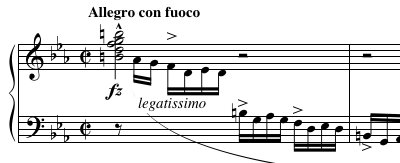
Etude op. 10 no. 12
Encyclopedia

C minor
C minor is a minor scale based on C, consisting of the pitches C, D, E, F, G, A, and B. The harmonic minor raises the B to B. Changes needed for the melodic and harmonic versions of the scale are written in with naturals and accidentals as necessary.Its key signature consists of three flats...
, known as the Revolutionary Étude or the Étude on the Bombardment of Warsaw, is a solo piano work by Frédéric Chopin
Frédéric Chopin
Frédéric François Chopin was a Polish composer and virtuoso pianist. He is considered one of the great masters of Romantic music and has been called "the poet of the piano"....
written circa 1831, and the last in his first set, Douze Grandes Études, dedicated "à son ami Franz Liszt" ("to his friend Franz Liszt
Franz Liszt
Franz Liszt ; ), was a 19th-century Hungarian composer, pianist, conductor, and teacher.Liszt became renowned in Europe during the nineteenth century for his virtuosic skill as a pianist. He was said by his contemporaries to have been the most technically advanced pianist of his age...
").
History
The 12th Étude appeared around the same time as the November UprisingNovember Uprising
The November Uprising , Polish–Russian War 1830–31 also known as the Cadet Revolution, was an armed rebellion in the heartland of partitioned Poland against the Russian Empire. The uprising began on 29 November 1830 in Warsaw when the young Polish officers from the local Army of the Congress...
in 1831. Chopin poured his emotions on the matter into many pieces that he composed at that time, the "Revolutionary Étude" standing out as the most notable example. Upon conclusion of Poland
Poland
Poland , officially the Republic of Poland , is a country in Central Europe bordered by Germany to the west; the Czech Republic and Slovakia to the south; Ukraine, Belarus and Lithuania to the east; and the Baltic Sea and Kaliningrad Oblast, a Russian exclave, to the north...
's failed revolution against Russia
Russia
Russia or , officially known as both Russia and the Russian Federation , is a country in northern Eurasia. It is a federal semi-presidential republic, comprising 83 federal subjects...
, he cried "All this has caused me much pain. Who could have foreseen it!"
Unlike études of prior periods (works designed to emphasize and develop particular aspects of musical technique), the romantic
Romantic music
Romantic music or music in the Romantic Period is a musicological and artistic term referring to a particular period, theory, compositional practice, and canon in Western music history, from 1810 to 1900....
études of composers such as Chopin and Liszt are fully developed musical concert pieces, but still continue to represent a goal of developing stronger technique.
Technique
In the case of the 12th Étude, the technique required in the opening bars is playing long, loud descending runs extremely fast in mainly the left hand, which forms a dominant seventh chordDominant seventh chord
In music theory, a dominant seventh chord, or major minor seventh chord,is a chord composed of a root, major third, perfect fifth, and minor seventh. It can be also viewed as a major triad with an additional minor seventh...
(or diminished seventh chord
Diminished seventh chord
A diminished seventh chord is a four note chord that comprises a diminished triad plus the interval of a diminished seventh above the root. Thus it is , or enharmonically , of any major scale; for example, C diminished-seventh would be , or enharmonically...
) introductory build-up to the main theme. The length and the repetition of these rapid passages distinguishes the Revolutionary from other Études.
Although the greatest challenge lies with the relentless left hand semiquavers, the right hand is also challenged by the cross-rhythms
Polyrhythm
Polyrhythm is the simultaneous sounding of two or more independent rhythms.Polyrhythm in general is a nonspecific term for the simultaneous occurrence of two or more conflicting rhythms, of which cross-rhythm is a specific and definable subset.—Novotney Polyrhythms can be distinguished from...
which are used with increasing sophistication to handle the same theme in various successive parallel passages.
The left hand technique in this piece involves evenly played semiquavers throughout. The structure is of the strophic
Strophic form
Strophic form is the simplest and most durable of musical forms, elaborating a piece of music by repetition of a single formal section. This may be analyzed as "A A A..."...
coda form (A A'). The opening broken chords (diminished chord with an added passing note) and downward passages transition into the main appassionato melody. The octave melody's dotted rhythms and the continuous accompaniment give an impression of tension. The piece ends by recalling the opening in a final descending sweep (with both hands) descending to a C major chord, although within a context that draws its expected function as a resolution into question.
Influences
The end of the 12th Étude alludes to Beethoven's last piano sonataPiano Sonata No. 32 (Beethoven)
The Piano Sonata No. 32 in C minor, Op. 111, is the last of Ludwig van Beethoven's piano sonatas. Along with Beethoven's 33 Variations on a waltz by Anton Diabelli, op. 120 and his two collections of bagatelles—Opus 119 and Opus 126 —this was one of Beethoven's last compositions for piano. The...
, written in the same key—a piece Chopin is known to have greatly admired (compare bars 77–81 in the Étude to bars 150–152 in the first movement (also ending in C major) of Beethoven's sonata.
External links
- Analysis of Chopin Etudes at Chopin: the poet of the piano
- Mutopia Project - A public domain engraving of the score using GNU LilyPondGNU LilyPondGNU LilyPond is a computer program for music engraving. One of LilyPond's major goals is to produce scores that are engraved with traditional layout rules, reflecting the era when scores were engraved by hand....
, available in several formats.

